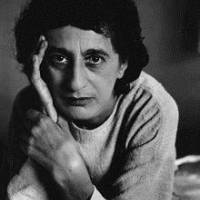(1899-1994)

Follow Anni ALBERS
Anni Albers was a textile artist, theorist, and printmaker of German origin who became a naturalized American citizen. Her work revolutionized the art of weaving by elevating it to the status of a major art form within modernism. Born Annelise Else Frieda Fleischmann on June 12, 1899, in Berlin, into a cultivated Jewish bourgeois family, she received an artistic education from a young age. She briefly studied at the Kunstgewerbeschule in Hamburg before joining the famous Bauhaus in Weimar in 1922, an avant-garde school that advocated the unity of art, craft, and industry.
Like many women at the time, she was directed to the weaving workshop, considered more "suitable" for women. Far from resigning herself to it, she transformed this constraint into a field of radical exploration. There, she developed a modernist approach to textiles, combining geometric rigor, color research, and the use of new materials, including industrial ones such as cellophane and nylon. In 1925, she married Josef Albers, painter and teacher at the Bauhaus, with whom she formed a deeply connected and mutually inspiring artistic couple.
Anni Albers became one of the central figures of the Bauhaus, especially after the school moved to Dessau. In 1931, she briefly led the weaving workshop. In 1933, with the rise of Nazism and the closure of the Bauhaus by the authorities, the Albers emigrated to the United States. They accepted an invitation to Black Mountain College, a progressive school in North Carolina, where Josef taught art and Anni founded the textile program. This place became a major hub for post-war American art experimentation.
Over the years, Anni Albers pursued her research into the structure of fabric, the relationship between materials, pattern, function, and abstraction. Her textile works, often functional pieces such as curtains or wall hangings, also possessed an aesthetic and poetic dimension that reflected the principles of concrete art and geometric abstraction. She was influenced by Pre-Columbian arts, especially Peruvian and Mexican textiles, which she discovered during her many travels in Latin America.
In 1949, the Museum of Modern Art (MoMA) in New York dedicated a solo exhibition to her – the first ever devoted to a textile artist – a sign of recognition for a medium long relegated to craft. From the 1950s onwards, she also devoted herself to printmaking (notably aquatint and screen printing), continuing her dialogue between structure and abstraction. She published several essays and major books, including On Weaving (1965), a fundamental text on the philosophy and practice of weaving.
Anni Albers had a decisive influence on the evolution of textile art, redefining the boundaries between art, craft, and design. Through a rigorous, luminous, and deeply intellectual body of work, she turned textile into a fully fledged artistic language. She also paved the way for a generation of female artists to claim artistic equality in media long considered minor.
She spent the final decades of her life in Orange, Connecticut, where she continued to create, write, and exhibit. She passed away in 1994 at the age of 94.

Secure payment
3DSecure 2.2

Free DHL Express delivery from €1,200
Carefully prepared parcel
Parcel tracking

Shipment insured
for the value of the artwork, covering theft and damages

Fairest prices
Certificate of authenticity
Two galleries in Paris
Receive an email as soon as a new artwork is added for this artist
Your message has been sent ! We will get back to you as soon as possible.
Please fill in the form if you need further information such
Please fill in your email address, an email will be sent with a link to update your password.
You can now place orders and track your orders.
To save your wishlist, you can log in or create an account :